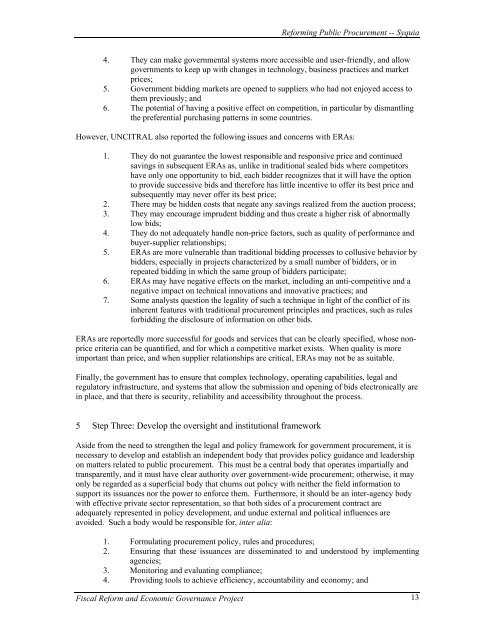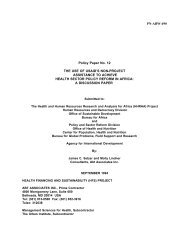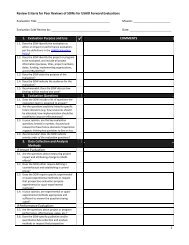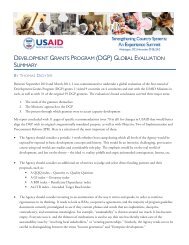Reforming Public Procurement in Emerging Market ... - KDID Portal
Reforming Public Procurement in Emerging Market ... - KDID Portal
Reforming Public Procurement in Emerging Market ... - KDID Portal
You also want an ePaper? Increase the reach of your titles
YUMPU automatically turns print PDFs into web optimized ePapers that Google loves.
<strong>Reform<strong>in</strong>g</strong> <strong>Public</strong> <strong>Procurement</strong> -- Syquia<br />
4. They can make governmental systems more accessible and user-friendly, and allow<br />
governments to keep up with changes <strong>in</strong> technology, bus<strong>in</strong>ess practices and market<br />
prices;<br />
5. Government bidd<strong>in</strong>g markets are opened to suppliers who had not enjoyed access to<br />
them previously; and<br />
6. The potential of hav<strong>in</strong>g a positive effect on competition, <strong>in</strong> particular by dismantl<strong>in</strong>g<br />
the preferential purchas<strong>in</strong>g patterns <strong>in</strong> some countries.<br />
However, UNCITRAL also reported the follow<strong>in</strong>g issues and concerns with ERAs:<br />
1. They do not guarantee the lowest responsible and responsive price and cont<strong>in</strong>ued<br />
sav<strong>in</strong>gs <strong>in</strong> subsequent ERAs as, unlike <strong>in</strong> traditional sealed bids where competitors<br />
have only one opportunity to bid, each bidder recognizes that it will have the option<br />
to provide successive bids and therefore has little <strong>in</strong>centive to offer its best price and<br />
subsequently may never offer its best price;<br />
2. There may be hidden costs that negate any sav<strong>in</strong>gs realized from the auction process;<br />
3. They may encourage imprudent bidd<strong>in</strong>g and thus create a higher risk of abnormally<br />
low bids;<br />
4. They do not adequately handle non-price factors, such as quality of performance and<br />
buyer-supplier relationships;<br />
5. ERAs are more vulnerable than traditional bidd<strong>in</strong>g processes to collusive behavior by<br />
bidders, especially <strong>in</strong> projects characterized by a small number of bidders, or <strong>in</strong><br />
repeated bidd<strong>in</strong>g <strong>in</strong> which the same group of bidders participate;<br />
6. ERAs may have negative effects on the market, <strong>in</strong>clud<strong>in</strong>g an anti-competitive and a<br />
negative impact on technical <strong>in</strong>novations and <strong>in</strong>novative practices; and<br />
7. Some analysts question the legality of such a technique <strong>in</strong> light of the conflict of its<br />
<strong>in</strong>herent features with traditional procurement pr<strong>in</strong>ciples and practices, such as rules<br />
forbidd<strong>in</strong>g the disclosure of <strong>in</strong>formation on other bids.<br />
ERAs are reportedly more successful for goods and services that can be clearly specified, whose nonprice<br />
criteria can be quantified, and for which a competitive market exists. When quality is more<br />
important than price, and when supplier relationships are critical, ERAs may not be as suitable.<br />
F<strong>in</strong>ally, the government has to ensure that complex technology, operat<strong>in</strong>g capabilities, legal and<br />
regulatory <strong>in</strong>frastructure, and systems that allow the submission and open<strong>in</strong>g of bids electronically are<br />
<strong>in</strong> place, and that there is security, reliability and accessibility throughout the process.<br />
5 Step Three: Develop the oversight and <strong>in</strong>stitutional framework<br />
Aside from the need to strengthen the legal and policy framework for government procurement, it is<br />
necessary to develop and establish an <strong>in</strong>dependent body that provides policy guidance and leadership<br />
on matters related to public procurement. This must be a central body that operates impartially and<br />
transparently, and it must have clear authority over government-wide procurement; otherwise, it may<br />
only be regarded as a superficial body that churns out policy with neither the field <strong>in</strong>formation to<br />
support its issuances nor the power to enforce them. Furthermore, it should be an <strong>in</strong>ter-agency body<br />
with effective private sector representation, so that both sides of a procurement contract are<br />
adequately represented <strong>in</strong> policy development, and undue external and political <strong>in</strong>fluences are<br />
avoided. Such a body would be responsible for, <strong>in</strong>ter alia:<br />
1. Formulat<strong>in</strong>g procurement policy, rules and procedures;<br />
2. Ensur<strong>in</strong>g that these issuances are dissem<strong>in</strong>ated to and understood by implement<strong>in</strong>g<br />
agencies;<br />
3. Monitor<strong>in</strong>g and evaluat<strong>in</strong>g compliance;<br />
4. Provid<strong>in</strong>g tools to achieve efficiency, accountability and economy; and<br />
Fiscal Reform and Economic Governance Project 13







